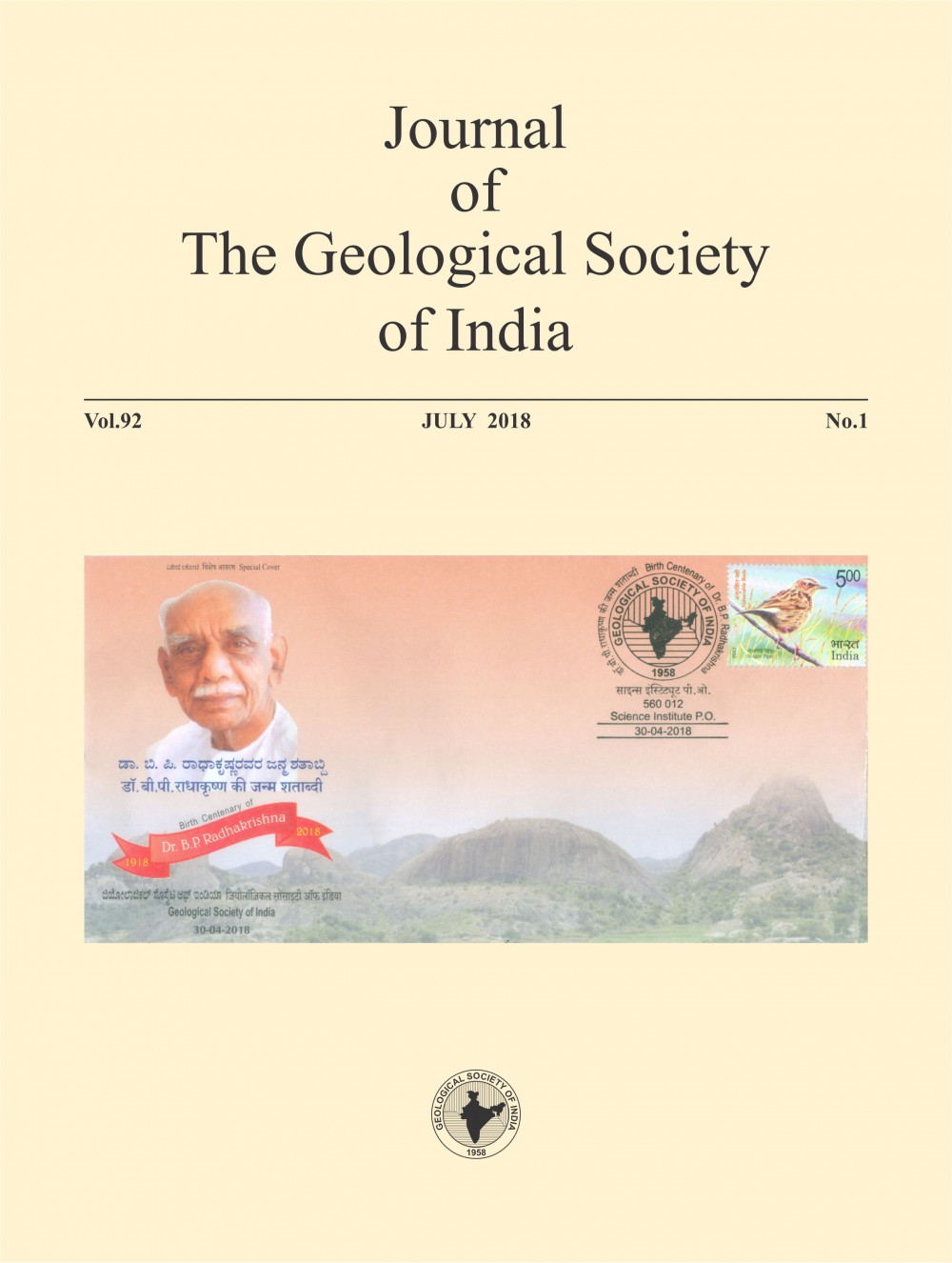Quantitative Geomorphological Analysis to Infer the Hydrological Behaviour of Streams Draining into the Vembanad Lake – A Ramsar Site along the Southwest Coast of India
DOI:
https://doi.org/10.1007//s12594-018-0951-5Abstract
Vembanad lake system (VLS) is a Ramsar wetland of premier importance along the south west coast of India. This system spread over 13098 km2 accounts for 33.7% of total geographic area of Kerala state. VLS sustains by the input of six main river systems of Kerala viz., Achankovil, Pampa, Manimala, Meenachil, Muvattupuzha and Periyar. Central focus of this study is to find out the influence of morphometric variables on hydrological processes using geo-informatics and correlation analysis and to analyse the scale dependence of basin hypsometry in steady state topography and hydrology. The study also examines the contribution of each river in making the entities of this wetland system by portraying the morphometric and hypsometric parameters of its watershed. The results of this analysis reveals that the Manimala river basin has survived with rapid denudation activities and run off mechanism, while Periyar and Pampa river basins have culminating stage of development and are tectonically active. This study immensely contributes to the knowledge on the influence of morphometric variables on hydrological process and scale dependence of basin hypsometry in steady state topography including hydrology of VLS. The results will shed some light on hydrologic makeup of inflow rivers and will be beneficial for the sustainable management of India's one of the premier wetlands.Downloads
Metrics
Issue
Section
Downloads
Published
How to Cite
References
Abrahams, A.D. (1984) Channel networks: a geomorphological perspective. Water Resour. Res., v. 20(2), pp. 161–188.
Baiju, C.K., Kumar, B.A., Gopinath, G., Chandran, M.S.S. and Ramkumar, T. (2015) GIS Based Morphometric Analysis of the Kochara Sub-Watershed of Greater Periyar Plateau (GPP) of South Western Ghats, India. Internat. Jour. Advanced Remote Sensing and GIS, v. 4(1), pp. 895.
Bishop, M.P., Shroder, J.F., Bonk, R., and Olsenholler, J. (2002) Geomorphic change in high mountains: a western Himalayan perspective. Global and Planetary Change, v. 32(4), pp. 311–329.
Dade, W.B. (2001) Multiple scales in river basin morphology. Amer. Jour.Sci., v. 301(1), pp. 60–73.
Dash, P., Aggarwal, S.P., Verma, N. and Ghosh, S. (2014) Investigation of scale dependence and geomorphic stages of evolution through hypsometric analysis: a case study of Sirsa basin, western Himalaya, India. Geocarto Internat., v. 29(7), pp. 758–777.
Geena, G.B. and Ballukraya, P.N. (2011) Morphometric analysis of Korattalaiyar River basin, Tamil Nadu, India: A GIS approach. Internat. Jour. Geomatics and Geosci., v. 2(2), pp. 383.
Horton, R.E. (1945) Erosional development of streams and their drainage basins; hydrophysical approach to quantitative morphology. Geol. Soc. Amer. Bull., v. 56(3), pp. 275–370.
Joseph, S. and Thrivikramaji, K.P. (2002) Kayals of Kerala coastal land and implication to Quaternary sea level changes. Late Quaternary Geology of India and Sea-Level Changes. Geological Society of India, Banagalore, pp. 51–64.
Kumar, P.K.D., Gopinath, G., Murali, R.M., and Muraleedharan, K.R. (2014) Geospatial Analysis of Long-Term Morphological Changes in Cochin Estuary, SW Coast of India, pp. 1315–1320. DOI: 10.2112/JCOASTRESD12-00244.1
Langbein, W.B. (1947) Topographic characteristics of drainage basins. US Government Printing Office USA.
Leopold, L.B., and Maddock, T. (1953) The hydraulic geometry of stream channels and some physiographic implications, v. 252, US Government Printing Office.
Menon, A. (1911) The Cochin State Manual. Ernakulam. Government Press.
Menon, N.N., Balchand, A.N. and Menon, N.R. (2000) Hydrobiology of the Cochin backwater system – a review. Hydrobiologia, v. 430, pp. 149–183.
Moussa, R. (2003) On morphometric properties of basins, scale effects and hydrological response. Hydrolog. Proc., v.17(1), pp.33–58.
Padmalal, D., Maya, K., Mohan, S.V. and Baburaj, B. (2014) Holocene landsea interactions and landform changes in the coastal lands of Vembanad lagoon, Kerala, SW India.
Pareta, K., Pareta, U., and Decisions, S. (2011) Quantitative morphometric analysis of a watershed of Yamuna basin, India using ASTER (DEM) Data and GIS. Internat. Jour. Geomat. Geosci., v. 2(1), pp. 248–269.
Singh, T., Golnaraghi, M.F., and Dubey, R.N. (1994) Sliding-mode/shapedinput control of flexible/rigid link robots. Jour. Sound and Vibration, v. 171(2), pp. 185–200.
Sinha-Roy, S. (2002) Hypsometry and landform evolution: a case study in the Banas drainage basin, Rajasthan, with implications for Aravalli uplift. Jour. Geol. Soc. India, v. 60(1), pp. 7–26.
Soman, K., Chattopadhyay, M., Chattopadhyay, S. and Krishnan Potti, G. (2002) Occurrence and water resource potential of freshwater lakes in South Kerala and their relation to the Quaternary geological evolution of the Kerala coast. Mem. Geol. Soc. India, no. 49, p. 21.
Srtvastava, V.K. and Mitra, D. (1995) Study of drainage pattern of Raniganj Coalfield (Burdwan District) as observed on Landsat-TM/IRS LISS II imagery. Jour. Indian Soc. Remote Sensing, v. 23(4), pp. 225.
Strahler, A.N. (1952). Hypsometric (area-altitude) analysis of erosional topography. Civil Engg., v. 101, pp. 1258-1262.
Thrivikramji, K.P., Joseph, S. and Narayana, A.C. (2007) Coastal wetlands of Kerala: Origin and evolution. In: Proc. Kerala Environ. Cong., pp. 36-48.

 M. S. Shylesh Chandran
M. S. Shylesh Chandran






